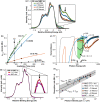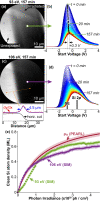EUV-induced hydrogen desorption as a step towards large-scale silicon quantum device patterning
- PMID: 38267459
- PMCID: PMC10808421
- DOI: 10.1038/s41467-024-44790-6
EUV-induced hydrogen desorption as a step towards large-scale silicon quantum device patterning
Abstract
Atomically precise hydrogen desorption lithography using scanning tunnelling microscopy (STM) has enabled the development of single-atom, quantum-electronic devices on a laboratory scale. Scaling up this technology to mass-produce these devices requires bridging the gap between the precision of STM and the processes used in next-generation semiconductor manufacturing. Here, we demonstrate the ability to remove hydrogen from a monohydride Si(001):H surface using extreme ultraviolet (EUV) light. We quantify the desorption characteristics using various techniques, including STM, X-ray photoelectron spectroscopy (XPS), and photoemission electron microscopy (XPEEM). Our results show that desorption is induced by secondary electrons from valence band excitations, consistent with an exactly solvable non-linear differential equation and compatible with the current 13.5 nm (~92 eV) EUV standard for photolithography; the data imply useful exposure times of order minutes for the 300 W sources characteristic of EUV infrastructure. This is an important step towards the EUV patterning of silicon surfaces without traditional resists, by offering the possibility for parallel processing in the fabrication of classical and quantum devices through deterministic doping.
© 2024. The Author(s).
Conflict of interest statement
The authors declare no competing interests.
Figures





References
-
- Škereň T, Köster SA, Douhard B, Fleischmann C, Fuhrer A. Bipolar device fabrication using a scanning tunnelling microscope. Nat. Electron. 2020;3:524–530. doi: 10.1038/s41928-020-0445-5. - DOI
-
- Campbell, Q. et al. Reaction pathways of BCl3 for acceptor delta-doping of silicon. 2022 [Online]. Available: http://arxiv.org/abs/2201.11682.
-
- Kane BE. A silicon-based nuclear spin quantum computer. Nature. 1998;393:133–137. doi: 10.1038/30156. - DOI
Grants and funding
- EP/M009564/1/RCUK | Engineering and Physical Sciences Research Council (EPSRC)
- EP/L015277/1/RCUK | Engineering and Physical Sciences Research Council (EPSRC)
- EP/M009564/1/RCUK | Engineering and Physical Sciences Research Council (EPSRC)
- EP/L015277/1/RCUK | Engineering and Physical Sciences Research Council (EPSRC)
- EP/M009564/1/RCUK | Engineering and Physical Sciences Research Council (EPSRC)
- EP/L015277/1/RCUK | Engineering and Physical Sciences Research Council (EPSRC)
- EP/M009564/1/RCUK | Engineering and Physical Sciences Research Council (EPSRC)
- EP/L015277/1/RCUK | Engineering and Physical Sciences Research Council (EPSRC)
- 810451/EC | Horizon 2020 Framework Programme (EU Framework Programme for Research and Innovation H2020)
- 810451/EC | Horizon 2020 Framework Programme (EU Framework Programme for Research and Innovation H2020)
LinkOut - more resources
Full Text Sources
Other Literature Sources
Miscellaneous

